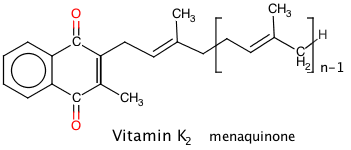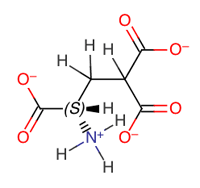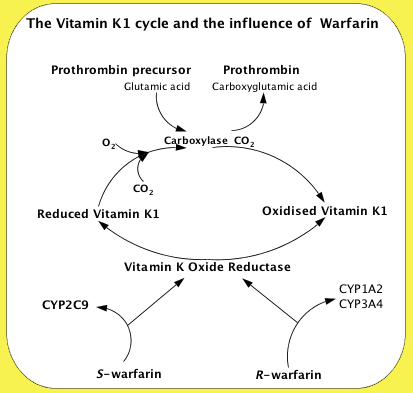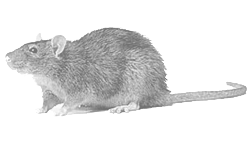The Biochemistry of Warfarin Action
This is a complex biochemical and medical subject, certainly beyond the simple chemistry required for
a molecule of the month! Warfarin acts as a Vitamin K antagonist, that is it blocks the action of
vitamin K epoxide reductase.
Vitamins K1 and K2

This vitamin is found in brassicas, spinach, parsley, and other green vegetables, avocado
pairs are also rich in Vitamin K1.

For Vitamin K2, n signifies a number of five-carbon side chain units, hence MK-n,
and except for MK4, is synthesised by gut bacteria. Both vitamins are fat soluble,
the "K" deriving from the German "koagulation". German researchers discovered the K vitamins,
and that they are involved in blood clotting.
Vitamin K Cycle

Vitamin K is a cofactor in the synthesis of blood clotting factors II, VII,
IX and X*, this step occurs
in the liver and involves the gamma carboxylation of the first 10 glutamic acid residues
in the amino-terminal region of the prothrombin clotting factor to generate gamma-carboxyglutamate.
The gamma-carboxyglutamatee amino acid groups can chelate Ca2+ better than
ten replaced glutamate residues, thus
providing binding sites for four
Vitamin Ks onto the phospholipid membrane during coagulation. The clotting occurs via a cascade*, a
kind of biochemical chain reaction.
{See Biochemistry by Stryer for the terminology}
 To work, the Vitamin K must be reduced to its quinol or hydroquinone form.
This is achieved with Vitamin K Oxide reductase, which is the step inhibited
by S-warfarin, being some three times more potent than R-warfarin.
S-warfarin is metabolized primarily by the CYP2C9 enzyme of the cytochrome P450 system.
The R-warfarin is metabolized by the two cytochrome P450 enzymes,
CP1A4Y and CYP3A4. Warfarin is very soluble in water, and is absorbed into
the blood stream within 90 minutes of taking the pills.
To work, the Vitamin K must be reduced to its quinol or hydroquinone form.
This is achieved with Vitamin K Oxide reductase, which is the step inhibited
by S-warfarin, being some three times more potent than R-warfarin.
S-warfarin is metabolized primarily by the CYP2C9 enzyme of the cytochrome P450 system.
The R-warfarin is metabolized by the two cytochrome P450 enzymes,
CP1A4Y and CYP3A4. Warfarin is very soluble in water, and is absorbed into
the blood stream within 90 minutes of taking the pills.
So far as the enantiomers are concerned, racaemic warfarin has a half life of
around 40 hours, the two enantiomers, having half lives: R-warfarin, 45 hours;
S-warfarin, 29 hours.
During my review for MoTM, necessarily hurried, I have not been able to
find out if the hemiketal, with the four enantiomers is involved. That the hemiketal
is weak is shown by the crystal structure study, so, in any case these
enantiomers will have short half lives. It all adds to the complexity.
The relationship between
the dose of warfarin and the response is modified by genetic and environmental factors
that can influence the absorption of warfarin, its pharmacokinetics, and its pharmacodynamics.





 To work, the Vitamin K must be reduced to its quinol or hydroquinone form.
This is achieved with Vitamin K Oxide reductase, which is the step inhibited
by S-warfarin, being some three times more potent than R-warfarin.
S-warfarin is metabolized primarily by the CYP2C9 enzyme of the cytochrome P450 system.
The R-warfarin is metabolized by the two cytochrome P450 enzymes,
CP1A4Y and CYP3A4. Warfarin is very soluble in water, and is absorbed into
the blood stream within 90 minutes of taking the pills.
To work, the Vitamin K must be reduced to its quinol or hydroquinone form.
This is achieved with Vitamin K Oxide reductase, which is the step inhibited
by S-warfarin, being some three times more potent than R-warfarin.
S-warfarin is metabolized primarily by the CYP2C9 enzyme of the cytochrome P450 system.
The R-warfarin is metabolized by the two cytochrome P450 enzymes,
CP1A4Y and CYP3A4. Warfarin is very soluble in water, and is absorbed into
the blood stream within 90 minutes of taking the pills.